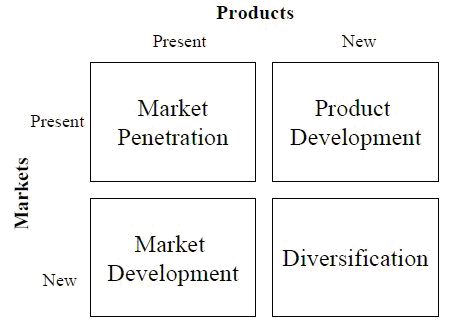Classic Ways to Grow Your Business
Alan Kaplan
Marketing strategies are vital to any organisation. Whilst there are many different strategic models that are regarded as sophisticated in today’s business environment, some classic and conceptually simple strategies are as valid today as the time they were conceived.
In 1957 Igor Ansoff developed his now famous growth matrix. Whilst some regard it as simplistic in today’s times the fundamentals on which it is based remain sound and companies of all sizes continue to successfully apply the principles.
In essence the matrix is a tool that helps businesses choose the best product and market growth strategy relative to circumstances. In some instances more than one option can be implemented providing this is done in a logical sequence.
Over time I have successfully helped companies of all sizes grow in each of the above segments and corporates and SME’s alike may derive value from the strategies in the matrix, and the examples provided.
Market penetration is the least risky strategy and focuses on selling existing products into existing markets to enhance market share and profitability. This can be achieved by improving branding & marketing efforts and promotion, loyalty programs and in other innovative ways.
An interesting example of enhanced market penetration occurred at the onset of my marketing career with Cadbury Schweppes internationally, at which time consumers were encouraged to use Roses Lime Juice as a mixer in innovative ways resulting in a significant sales increase. I received similar results with Cadbury Smash (instant mash) when a series of recipe leaflets and in- store demonstrations depicted how the product could be used on a far broader front. Both initiatives were well supported with broader marketing and PR endeavours.
Market penetration has generally played a major role in successful brand development activities over time. Recently in Australia I have been involved in assisting a broad range of companies, including those in the fmcg sector, to increase their sales through enhanced branding, marketing and communications.. In this regard adding emotional and/or self expressive values and conveying this in optimal fashion has played a significant role.
Product Development can be classified as a strategy carrying a medium degree of risk. It involves the introduction of new products into existing markets. As an example as consultant to Agrevo (Environmental Health), I made a significant contribution to growing Finale (Rodenticide) to the leading brand in its class.
An issue with the product was that it was initially only available in pellet form for indoor use.
Working closely with the company a new waterproof cube was developed specifically for outdoors. After relevant changes were made to minimise the impact on the environment this version was launched with great success as it enabled the brand (which was a single dose kill) to position itself as the total solution for rodent problems, a move that proved highly effective.
By way of further example, Kellogg’s utilised a product development strategy most successfully for Nutri- Grain Bars when customer tastes changed markedly in the UK at which time far more acceptable product options were launched and others withdrawn.
In Australia Optivance 360 works with a range of companies from SME’s to listed companies in the area of product development.
Market Development is a strategy whereby a business introduces existing products into new markets. Like product development this is also regarded as having a medium degree of risk.
Initially Agrevo’s environmental health range focussed on the agricultural and consumer sectors but their success was further enhanced through the introduction of excellent products into new markets such as the hospitality and health sectors. This involved niche marketing and additional product distribution which we initiated.
As marketing manager of Cadbury Schweppes I utilised this strategy to develop markets in designated country areas, through marketing initiatives undertaken across a broad front including the introduction of mobile marketing trucks that undertook sampling. In addition export initiatives proved most successful.
Optivance 360 is currently involved in a number of market development projects across different sectors.
Diversification carries the highest risk of all four strategy options as it involves a business introducing a new product to new markets in which it generally has far less, little, or no experience. A company must therefore evaluate the decision to diversify with relatively more caution. Some companies such as Virgin have generally diversified most successfully, but have nevertheless failed at times, as was the case with Virgin Cola.
During my tenure with Agrevo as advertising and marketing consultant I assisted the group to successfully diversify into the gardening sector, although the risk was mitigated through the introduction of a well experienced business partner for Agrevo in this area. Nevertheless comprehensive market research played a major role in securing the positive outcomes, as outlined in an article on this website.
Furthermore, I derived a strategy that enabled an OTC pharmaceutical company to diversify into niche cosmetic and other areas with significantly positive outcomes.
In reviewing the Ansoff matrix and examples above SME’s should give thought to which of the strategies, or combination thereof is best for their needs. In addition to the Ansoff matrix other tools and considerations should be considered before formulating and implementing a comprehensive growth strategy from a marketing perspective.
About the writer
Alan Kaplan PhD has international experience spanning more than twenty five years across academic, media, agency, client and consulting areas. Alan’s profile can be viewed on LinkedIn and he can be contacted on 041875855.
Contact us
Contact Optivance 360 for a no obligation discussion on how we can assist you with all your branding, marketing and communications in a consulting, non executive management or mentoring capacity, or for any of our other key business services including franchising.
Alan Kaplan © 2012
This article is for general information and the reader should seek specific expert advice before taking any action.
Posted in: Strategy
Leave a Comment (0) ↓
